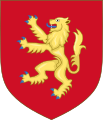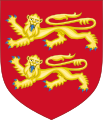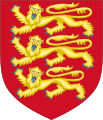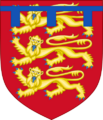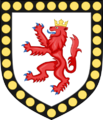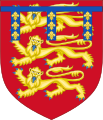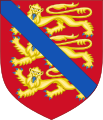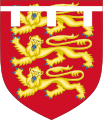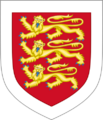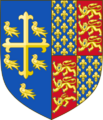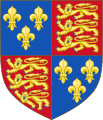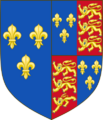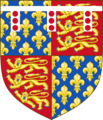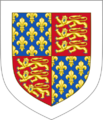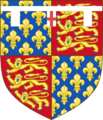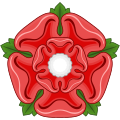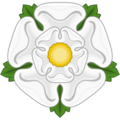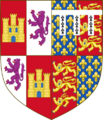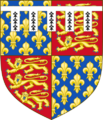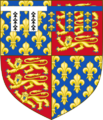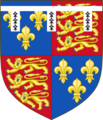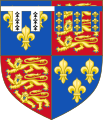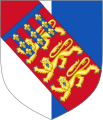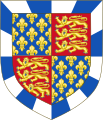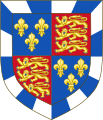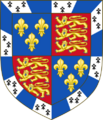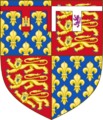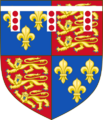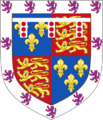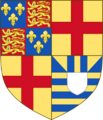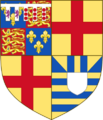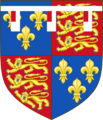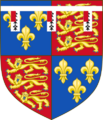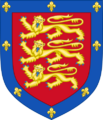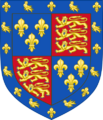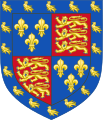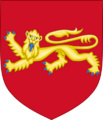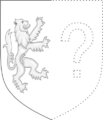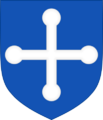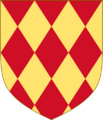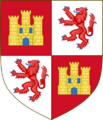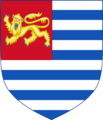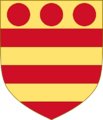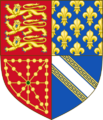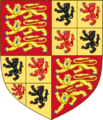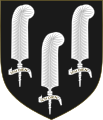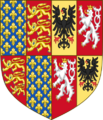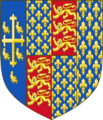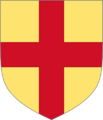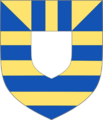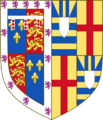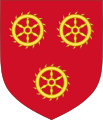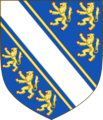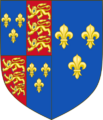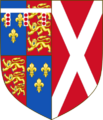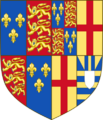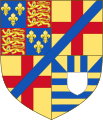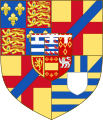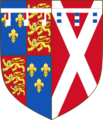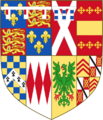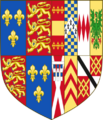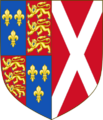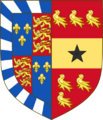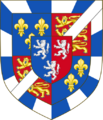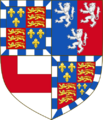Armorial of the House of Plantagenet facts for kids
The House of Plantagenet was a very important royal family in England. They were the first English kings to truly use coats of arms to show who they were. Before them, King Henry I of England had given items with a lion symbol to his son-in-law, Geoffrey, Count of Anjou, who started the Plantagenet family.
Geoffrey's family tried out different lion designs for their shields. But it was his grandson, King Richard I (who ruled from 1189 to 1199), who settled on a famous design: three golden lions walking across a red shield. This became the official Royal Arms of England, and people often just called them the arms of England itself.
Later family members, like different branches of the Plantagenets, would change these arms slightly to show their own family line. Sometimes they would even combine their arms with others to show their claims to land or power.
Contents
What are Coats of Arms?
A coat of arms is like a special symbol or picture that a family, country, or group uses. It's usually shown on a shield. These symbols helped people in the past know who was who, especially in battles or tournaments. Each part of the design, like the colors and animals, has a special meaning.
The First Plantagenet Arms

The very first Plantagenet, Geoffrey Plantagenet, Count of Anjou, used a shield with six golden lions on a blue background. This was a strong symbol for his family.
His son, King Henry II of England, might have used a single lion on his shield, but we don't have clear pictures from his time. It's a bit of a mystery!
The Famous Three Lions
The three lions we know today became famous with King Richard I, also known as "the Lionheart." His second royal seal clearly showed three golden lions walking across a red shield. This design was then used by many kings after him, including:
- King John (1199–1216)
- King Henry III (1216–1272)
- King Edward I (1272–1307)
- King Edward II (1307–1327)
These three lions became the main symbol of England for a long time.
New Arms for New Claims: Edward III
King Edward III (1327–1377) made a big change to the royal arms. In 1340, he claimed he should be the King of France because of his mother, Isabella. To show this claim, he added the French royal symbol – golden fleurs de lys (lily flowers) on a blue background – to his shield.
His new shield was divided into four sections:
- Two sections showed the French fleurs de lys.
- Two sections showed the English three lions.
This was a way of saying, "I am the rightful king of both England and France!"
Different Branches, Different Arms
The Plantagenet family grew very large, and different branches of the family used slightly changed versions of the royal arms. This was called "cadency" and helped show which part of the family someone belonged to. They would add small symbols like:
- A "label" (a strip of cloth with points) across the top of the shield.
- A "bordure" (a border) around the edge of the shield.
- Different colors or small shapes like "torteaux" (red circles).
The Black Prince and Richard II
Edward, the Black Prince, who was Edward III's eldest son, used the new "France and England" arms with a white label across the top. His son, King Richard II (1377–1399), used a very special shield. He combined the royal arms with the arms of Edward the Confessor, an old English saint. This showed his connection to England's ancient past.
The Houses of Lancaster and York
Two very important Plantagenet family branches were the House of Lancaster and the House of York. They fought a long war called the Wars of the Roses over who should be king.
House of Lancaster
The House of Lancaster came from John of Gaunt, a son of Edward III. When his son, Henry Bolingbroke, became King Henry IV (1399–1413), he made another change to the royal arms.
The kings of France had changed their arms from many fleurs de lys to just three. So, Henry IV changed the English royal arms to match, using three fleurs de lys for France. This new design was called "France Moderne."
Kings like Henry V and Henry VI continued to use these arms.
House of York
The House of York came from Edmund of Langley, another son of Edward III. They also used the "France and England" arms, but with their own special labels to show their family line.
When Edward, Earl of March, became King Edward IV (1461–1483), he continued to use the "France Moderne" and England arms. His brother, King Richard III (1483–1485), was the last Plantagenet king. He also used these arms.
The Beaufort Family
The House of Beaufort was another important family connected to the Plantagenets. They were the children of John of Gaunt and his third wife, Katherine Swynford, born before they were married. Even though they were "illegitimate" (born outside of marriage), they were later made legitimate by law.
The Beauforts used the royal arms with a special "bordure componée" (a border made of alternating squares of silver and blue) to show their connection to the royal family but also their unique situation.
One very famous Beaufort was Lady Margaret Beaufort, who was the mother of Henry Tudor. Henry Tudor defeated Richard III and became King Henry VII, starting the House of Tudor and ending the Plantagenet rule.
Images for kids
See also



